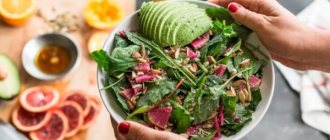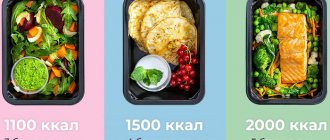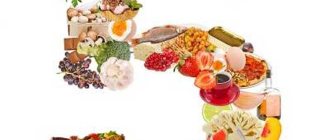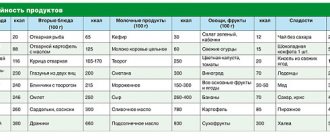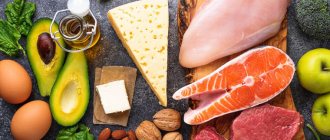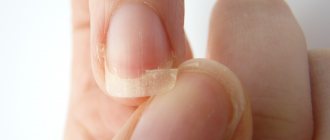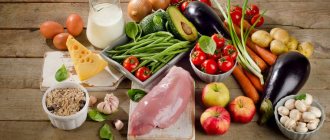Basic Rules
The main idea of this diet is that a person’s daily diet should not exceed 1000 calories. In this case, any products can be consumed. To better understand how this scheme works, you should understand the volume of calories in more detail.
Calories are the generally accepted units of measurement of the energy value of food. Together with other indicators (content of proteins, carbohydrates and fats), the calorie content of food is an important characteristic of nutritional value. Calories entering the human body become the main source of energy for performing physical and mental work. Each person has individual calorie needs. They largely depend on gender, age and rhythm of life.
| Groups of people according to the intensity of their work | Age | Men | Women |
| People engaged in mental work, employees (their work does not require physical activity) | 18–40 40–60 | 2800–3000 2600–2800 | 2400–2600 2200–2400 |
| People engaged in mechanized labor and in the service sector (salespeople, telephone operators) | 18–40 40–60 | 3000–3200 2800–3000 | 2500–2700 2300–2500 |
| People engaged in production with medium-heavy labor (machine workers) | 18–40 40–60 | 3200-3400 2900–100 | 2700-2900 2500–2700 |
| People working in production under difficult working conditions (metallurgists, miners) | 18–40 40–60 | 3700–3900 3400–3600 | 3100–3300 2900–3100 |
| Older people | 60–70 over 70 | 2300–2500 2200 | 2100–2200 2000 |
The peculiarity is that the daily diet of most people consists of more calories than the body needs. Unused calories are stored in tissues as fat deposits.
A 1,000-calorie-a-day diet is designed to create a deficit in dietary energy. To replenish the required amount, the body will begin to use its own reserves. As a result, excess weight will also be reduced.
There are a number of rules that must be followed.
- The food consumed should contain vitamins, minerals, fats, carbohydrates and proteins.
- A fractional diet is preferable. This term should be understood as eating small portions 5-6 times a day. This is explained by the fact that in the 2–3 hours between frequent snacks, the body does not have time to completely digest the incoming amount of food, due to which hunger is felt less.
Advantages and disadvantages
Before deciding whether such a diet is suitable in each case, you should study the advantages and disadvantages of this scheme.
The list of advantages can include the following features.
- Diet variety. Unlike many other diets, this option allows you to eat a large number of foods, which reduces the risk of failure. The diet can be chosen by those for whom mono-diets are not suitable.
- Weight loss. Using this approach, you can get rid of 0.5–2 kg per week.
- Efficiency. You can achieve results in 2–4 weeks. The short period makes the diet suitable even for those who find it difficult to limit themselves in nutrition for a long time.
The following features should be mentioned as disadvantages.
It is necessary to count calories per day
- The need for calculations. To prevent exceeding 1000 calories, those losing weight must calculate the energy value of each product. This problem can be solved by using basic recipes.
- Strict restriction on food. If you consume 1000 calories a day, you will experience a lack of energy. This will be expressed by a strong feeling of hunger.
The best foods for your diet
A menu for 1000 calories a day can include any vegetables, herbs, and almost all types of fruits. You can eat low-fat fermented milk products, eggs, poultry, and lean fish.
Porridges are an excellent dietary dish:
- oatmeal;
- barley;
- pearl barley;
- buckwheat;
- Brown rice.
Among thermal methods of processing food, you should avoid frying and more often resort to stewing, baking and steaming. It is better to cook porridge simply in water, and soups in vegetable rather than meat broth.
Coffee should be replaced with herbal tea. The daily rate of water consumption (drinks do not count) is at least two and a half liters. You can drink before a meal, but in no case during a meal or immediately after it, since water entering the stomach dilutes the hydrochloric acid contained there, thereby worsening the digestion process.
Selecting foods and calculating their calorie content
The list of basic principles in this diet calls fractional nutrition. At the same time, each meal should contain a standard recommended set of low-calorie foods:
- First breakfast. During it you should consume slow carbohydrates. This name refers to bread, cereals and grain crops. Along with carbohydrates, the body should receive low-fat proteins (cottage cheese and eggs) during the first breakfast. Such requirements are explained by the long digestibility of products, which provides a person with a long-lasting feeling of fullness.
- Second breakfast (or lunch). Nutritionists recommend including nuts, juice or fruits.
- Dinner. Soups with fish or chicken broth are suitable for this meal. You can consume lean meat and stewed vegetables.
- Afternoon snack. The snack consists of nuts, dairy products and fruits.
- Dinner. For dinner you can prepare vegetables with seafood, as well as a small piece of fish or meat.
- Evening snack. At this time, it is recommended to drink some fermented milk products. If you feel very hungry, you can eat a spoonful of honey or a few nuts.
To properly build a diet, you should use a large number of different foods with low energy content.
There is also a list of products that are not recommended for use in the diet:
- sugar and sugar-containing products;
- fatty food;
- products containing flavor enhancers, preservatives and starch;
- mayonnaise and other sauces;
- semi-finished products (sausage, frankfurters);
- high fat cheese;
- potato.
When counting calories, there are several rules to follow.
- Using a kitchen scale. All foods prepared for food during the diet must be weighed. This will help you know as accurately as possible the amount of energy entering the body.
- Application of calorie tables. Using such tables, you can quickly calculate the calorie content of a dish.
- Diet diary. Keeping detailed records of the foods you consume will prevent you from eating too much.
When planning a menu, you need to take into account the following rules for the distribution of energy value:
- breakfast - 200–250 calories;
- second breakfast - 150 calories;
- lunch - 400 calories;
- dinner - 200 calories.
If there are still unused calories from lunch (the dish contained 350 calories), then dinner cannot be 50 calories more nutritious. The lack of energy can be compensated by having a light snack a couple of hours after lunch.
Sample menu for 7 days
At first glance, all of the above rules and restrictions seem extremely strict, however, the proposed version of the ready-made menu can dispel such thoughts.
Monday:
- breakfast - 2 diet bread (can be replaced with a piece of rye bread), 40 g of low-fat cottage cheese or 100 ml of fermented milk product (ryazhenka, kefir, unsweetened yogurt);
- second breakfast - 1 any fruit (peach, pear, apple, orange);
- lunch - soup with legumes (250 g), 100 g of boiled chicken or 130 g of fish;
- afternoon snack - 2 walnuts or a small cob of corn;
- dinner - 100 g of porridge (buckwheat or oatmeal), 1 tomato, 1 boiled egg.
Tuesday:
- breakfast - a piece of bran bread, 150 g of butter, 1 boiled egg and 200 ml of milk;
- lunch - 1 fruit of your choice;
- lunch - 200 ml of soup with vegetable broth (can be replaced with stewed vegetables), 100 g of meat and 150 g of salad (cabbage with cucumber);
- afternoon snack - a piece of bread with 15 g of cheese or 60 g of cottage cheese without additives, a glass of milk (200 ml);
- dinner - 100 g of steamed fish, 200 ml of kefir or unsweetened yogurt, 200 g of grilled vegetables.
Wednesday:
- breakfast - soft-boiled egg, 2 diet bread, tea (or weak coffee), grapefruit;
- second breakfast - vegetable broth (200 ml);
- lunch - 200 g of boiled vegetables, 100 g of meat and 100 g of any fruit;
- afternoon snack - low-fat cottage cheese or cheese (25 g), a slice of rye bread, buttered (10 g), 200 ml of fruit broth;
- dinner - 200 g of vegetables, 100 g of meat, 100 g of fruit.
Thursday:
- breakfast - 200 ml milk, 2 whole grain toasts;
- second breakfast - small grapefruit;
- lunch - 140 g of fish or meat dish (optional), 400 g of chopped vegetables, 160 g of porridge;
- afternoon snack - apples 300 g;
- dinner - 60 g of cottage cheese with berries, 400 mg of vegetable soup.
Friday:
- breakfast - 15 g of cheese, a piece of rye bread, greased with 10 g of butter, coffee with skim milk (or tea);
- lunch - a glass of any berries or 2 apples;
- lunch - 200 g pollock or other fish (boiled or steamed), 300 g tomato;
- afternoon snack - 3 small apples;
- dinner - 100 g of low-fat cottage cheese with the addition of 30 g of raisins and cocoa with milk without sugar.
Saturday:
- breakfast - an omelet made from 2 eggs, coffee or tea with milk;
- second breakfast - 100 g of berries of your choice;
- lunch - 160 g of stewed or boiled veal, garnish: 160 g of porridge, 300 g of tomatoes;
- afternoon snack - 300 g pears;
- dinner - 400 ml vegetarian cabbage soup, 100 g cottage cheese, 1 medium-sized apple.
Sunday:
- breakfast - 2 hard-boiled eggs, coffee or tea;
- second breakfast - grapefruit;
- lunch - any soup with vegetable broth (400 ml), 200 g of steamed fish, 100 g of berries;
- afternoon snack - large apple (250 g);
- dinner - 100 g of ham and lettuce.
This menu is one of the possible ones. Each person following such a diet can create the optimal menu independently.
1000 calorie diet results
By following all the requirements and recommendations of this diet, you can lose 0.5–2 kg per week without harm to your health. Weight loss occurs most quickly during the first few days.
At the same time, doctors emphasize: this method is considered emergency. It should be used if a person needs to quickly lose a few kilograms. Being in a calorie deficit for a long time can cause health problems. For this reason, you cannot stick to the diet for more than 3 weeks.
How many calories are in a kilogram of human fat?
If you were wondering how many calories are in 1 kg of human fat, the answer may be very surprising - after all, a kilogram contains 7716 calories. One gram of pure fat contains nine kilocalories. This figure differs from the previous figure because we are talking about pure fat. Our body is very complex in composition: there is fluid and muscle mass, connecting tissues, as well as other compounds that aggravate fat weight.
Food labels do not take these impurities into account, but when calculating calories from fat tissue, the number may be incorrect if you do not pay attention to these impurities. So, how many calories are in one kilogram of fat? There are only 7 of them, not the usual 9 for us.
The problem of excess weight is very relevant nowadays. If people knew how many kilocalories are in a kilogram of fat, they could easily calculate the daily intake of proteins, fats and carbohydrates for their goals. To lose weight, you need to create a kcal deficit by removing empty and complex carbohydrates from your diet as much as possible.
The main food when losing weight is protein, which builds our muscles, which in turn displace the fat layer from the body. Protein is also necessary for weight gain, but in this case, you can stick to complex rather than empty carbohydrates. With sufficient protein intake, the amount of fat will also increase, but within reasonable limits.
Useful tips for those on a diet
To achieve better results and maintain a good mood during the diet, you should take note of a few tips. They will make it easier to cope with dietary restrictions and help you stay healthy.
There are 3 main meals, the remaining 2 are snacks. Second breakfast and afternoon snack should contain 2 times less calories than main meals.
- The break between meals should not exceed 3–3.5 hours.
- During the diet, you should consume at least 1.5–2 liters of water.
- You should go to bed at least 1.5 hours after dinner.
- Meals should be at the same time according to the schedule.
- It is not recommended to drink water half an hour before meals. After eating, at least an hour should pass.
- To avoid the reduction in portions being obvious, you should use small plates.
- To achieve a feeling of fullness, food should be placed in the mouth in small pieces and chewed slowly and thoroughly.
Basic principles of the diet
The daily diet should be divided into three main meals and additionally include one or two snacks. Traditional three meals a day is not suitable for this diet for the following reasons:
- If the body does not receive energy on time with a new portion of food, it stops actively spending its existing reserves and stores them in the form of fat.
- Feeling hungry leads to overeating at the next meal.
- Long breaks between breakfast, lunch and dinner lead to a decrease in blood glucose levels and provoke the production of the stress hormone cortisol. As a result, metabolism is disrupted.
- Only fractional nutrition in small portions allows the body to fully absorb all the nutrients from food.
To calculate calories, you will need a food calorie table and a kitchen scale to weigh portions. It is necessary to distribute the caloric content of meals so that most of the calories are consumed in the first half of the day.
For example:
- first breakfast – 300 calories;
- second breakfast – 100;
- lunch – 400;
- dinner –200.
Breaks between meals should not last more than three hours.
A lack of calories can cause exhaustion of the body. Even a healthy person should not eat this way for more than one month. If you want to extend the diet for a longer period, you need to take a break for four to five weeks, increasing the daily calorie intake to at least 1700 during this time. If you do not follow this recommendation, you can slow down your metabolism and cause weight loss.
Reviews of the 1000 calorie per day diet
Olesya, 25 years old, Moscow
I decided to try this diet, but had little faith in achieving results. I had already tried several diets before, but they didn’t help. This time everything worked out. In 2 weeks I managed to get rid of 3.5 kg. Now all that remains is to save the result.
Among the advantages of the diet, I can note the content of a large number of different foods. This saves because... there is less desire to eat something “wrong”. Before this I was on a mono-diet, but after it I want everything at once. As a result, you gain more weight. The only drawback for me in this diet is the need to calculate and weigh everything.
Elena, 38 years old, Tambov
I couldn’t stand the diet for more than 3 days. Firstly, the feeling of hunger often made it impossible to think about anything else other than food. Perhaps this is due to the peculiarity of my work schedule (after all, a lot of energy is required on my feet all day). Secondly, the complete absence of sweets is hard for me.
Recipes for suitable dishes
Fish casserole
100 g of the dish contains about 100 calories. This largely depends on the type of fish used.
To prepare you will need:
- cauliflower;
- fish fillet;
- tomato;
- bulb;
- greenery.
The cabbage is disassembled into inflorescences and placed in a mold. Pieces of fish fillet are placed in the center of the mold. Place tomato slices, onion rings, and greens on top. Bake for 20–30 minutes.
Omelette with vegetables
150 g of dish contains 200 calories.
Ingredients:
- whites of 2 eggs;
- 2 tbsp. l. milk;
- a small amount of cauliflower, zucchini, broccoli or green beans.
Vegetables are chopped, lightly simmered and placed in a heat-resistant form. Beat the egg whites with the addition of milk and pour this mixture over the vegetables. Cover the top of the pan with foil and bake in the oven for 5–7 minutes.
Vegetable broth soup (vegetarian)
300 ml of soup contains 70 calories. To prepare you will need:
- 2 liters of water;
- celery root;
- 1 carrot;
- 100 g cauliflower;
- 100 g zucchini;
- greenery;
- 1 clove of garlic;
- 1 boiled egg.
Cut vegetables into small cubes. To boil water. When the water starts to boil, you need to add carrots and celery, and after 5 minutes, zucchini and cabbage. Salt and add spices to taste. A few minutes before the end of cooking, add chopped garlic and herbs to the soup. Place a boiled egg, cut into slices, into a bowl of soup.
List of dishes
You can stick to the same diet, but reduce the portion to the required number of calories. If you have the time and desire to prepare delicious and healthy dishes, then algorithms will help you calculate calorie content.
It must be taken into account that food has the ability to boil down, decrease in size, and release beneficial properties to water. The least amount of vitamins is lost when stewing or steaming.
Healthy first breakfast
Cereals are ideal to start the day. Therefore, the best breakfast is buckwheat or oatmeal with milk or kefir, with the addition of honey, fruits, and berries. A good nutritious meal would be an omelette and whole grain bread.
You can make lazy oatmeal the night before. The recipe does not require any special ingredients; you will need 300 ml of skim milk, 3-5 tablespoons of oatmeal, apples or other available fruits.
The components are mixed in a glass container and infused for 5-7 hours. Overnight, the oatmeal will acquire a delicate consistency and will not lose its beneficial properties. Per serving – 300-350 kcal.
Light second breakfast
Lunch will give you energy until lunch and help you avoid having unhealthy extra snacks. If the second breakfast takes place in working conditions, the best option is:
- a handful of nuts, dried fruits;
- cereal bar;
- drinking yogurt.
If you have a lot of time, you can prepare a fruit salad from banana, kiwi, apple and orange, and season the resulting mix with natural yogurt.
The second version of the salad is grated apple with carrots and raisins. You can bake 6-8 oatmeal cookies for a week in advance from a mixture: beaten egg, oatmeal, honey, dried berries.
Full lunch
Hot dishes are a lunch that will restore strength and give energy for the rest of the day. Prepare vegetable or meat broths.
Buckwheat chicken breast soup will do
Ingredients:
- 1 chicken fillet;
- 2 liters of water;
- 70-100 grams of buckwheat;
- carrot;
- onion;
- greenery.
Preparation:
- The skinless chicken is placed in cold water, boiled until it boils, the foam is skimmed off, and the meat is pulled out.
- Add washed buckwheat and cook for 20-25 minutes.
- Do not cut the onion, boil until tender (to make the broth transparent) and discard.
- Grate the carrots and add them to the broth.
- The soup is decorated with herbs; 300 g of liquid and ¼ chicken breast are enough for one serving.
Small afternoon tea
In the afternoon, the body needs dairy and fermented milk products. Therefore, it is better to make an afternoon snack from kefir, cottage cheese, fermented baked milk, yogurt, thick yogurt with dried fruits and nuts.
Cooking cottage cheese casserole
Will need:
- 500 g cottage cheese;
- 2 tablespoons of semolina;
- 1 large chicken egg;
- honey;
- additives (fruits, nuts) to taste.
Preparation:
- The components are mixed and poured into the mold.
- Bake for 40 minutes at medium temperature. To prevent the dish from burning, cover the bottom with parchment.
Calorie content per 100 g – 170 kcal.
Light dinner
The evening meal should consist of 50-70% protein foods: boiled or stewed meat, eggs, cottage cheese, kefir. The carbohydrate part is vegetable salads or stews. It is better to allow up to 200 kcal for dinner, go to bed 3 hours after eating.
You can bake lean fish in foil. Hake, pollock, mullet are suitable; the carcass is cleaned of scales in advance, washed, salted, and sprinkled with lemon juice. Cover the baking sheet with foil and grease with vegetable oil.
Place carrots cut into slices, green beans, onion rings, and a whole fish on top. Cover the dish with a second sheet of foil and place in a preheated oven for 20 minutes. A piece weighing 100-150 g will yield 200 kilocalories.
